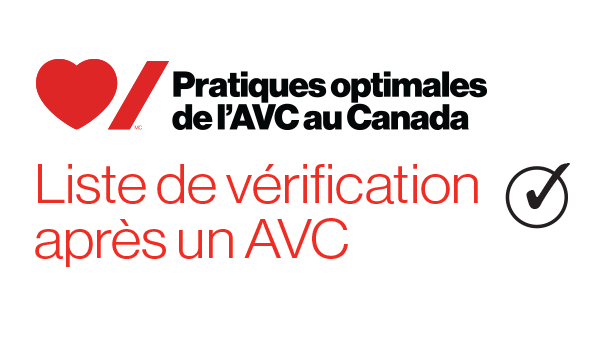- Définition et considérations
- 1. Évaluation initiale des besoins en matière de réadaptation post-AVC
- 2. Soins offerts dans les unités de réadaptation post-AVC
- 3. Prestation des soins de réadaptation post-AVC en milieu hospitalier
- 4. Réadaptation à domicile et en consultation externe post-AVC (y compris le congé précoce assisté)
- 5.1 Prise en charge des membres supérieurs après un AVC : principes généraux et traitements
- 5.2 Amplitude du mouvement et spasticité de l’épaule, du bras et de la main
- 5.3 Prise en charge de la douleur à l’épaule et du syndrome douloureux régional complexe (SDRC) après un AVC
- 6.1 Équilibre et mobilité
- 6.2 Spasticité des membres inférieurs après un AVC
- 6.3 Prévention et prise en charge des chutes
- 7. Évaluation et prise en charge de la dysphagie et de la malnutrition après un AVC
- 8. Réadaptation en cas de troubles de la perception visuelle
- 9. Prise en charge de la douleur centralisée
- 10. Réadaptation en vue d’améliorer la capacité à parler et à communiquer
- 11. Téléréadaptation après un AVC
2.1 Soins offerts dans les unités de réadaptation post-AVC
- Toutes les personnes qui ont besoin de soins de réadaptation post-AVC devraient être soignées dans une unité spécialisée en la matière [niveau de preuve A], qui présente les caractéristiques suivantes:
- Les soins de réadaptation sont dûment coordonnés et organisés [niveau de preuve A].
- L’unité de réadaptation est située dans un lieu bien défini [niveau de preuve A].
- L’unité de réadaptation se compose d’une équipe interdisciplinaire possédant une expertise ou une formation de base en réadaptation après un AVC, y compris des médecins (p. ex., des physiatres, neurologues ou autres médecins ayant la formation nécessaire), infirmiers, physiothérapeutes, ergothérapeutes, orthophonistes, travailleurs sociaux et nutritionnistes cliniciens [niveau de preuve A].
- Parmi les membres qui peuvent s’ajouter à l’équipe interdisciplinaire figurent les pharmaciens, les planificateurs de transition, les psychologues ou neuropsychologues, les spécialistes en soins palliatifs, les récréothérapeutes, les kinésiologues, les assistants en thérapie de réadaptation, les fournisseurs de soins spirituels, les pairs qui offrent du soutien et les représentants de groupes de soutien au rétablissement après un AVC [niveau de preuve C].
- Les personnes qui ont subi un AVC, leur famille et leurs aidants devraient participer activement dès le début du processus de réadaptation [niveau de preuve B].
- L’équipe en question suit les pratiques optimales fondées sur des données probantes, telles qu’elles sont définies par les lignes directrices consensuelles actuelles pour la pratique clinique [niveau de preuve B].
- La planification des transitions et du congé s’amorce dès l’admission à l’unité [niveau de preuve B]. Pour de plus amples renseignements, se reporter à la recommandation 3 du chapitre sur les transitions et la participation communautaire après un AVC des Recommandations
- L’instruction de la personne qui a subi un AVC, de sa famille et des aidants est offerte de manière formelle et informelle, individuellement ou en groupe, selon les besoins [niveau de preuve A]. Pour de plus amples renseignements, se reporter à la recommandation 2 du chapitre sur les transitions et la participation communautaire après un AVC des Recommandations.
- Les membres de l’équipe devraient avoir suivi une formation qui leur permet d’interagir avec des personnes qui éprouvent des difficultés à communiquer, comme celles atteintes d’aphasie, et d’utiliser des techniques de soutien à la conversation [niveau de preuve C].
- Les gens qui ont subi un AVC modéré ou grave et qui sont prêts à entreprendre un programme de réadaptation après s’être fixé des buts atteignables devraient avoir la possibilité de recevoir ces traitements en milieu hospitalier [niveau de preuve A].
- Lorsque l’hospitalisation d’un patient dans une unité de réadaptation spécialisée en soins post-AVC est impossible, la meilleure solution est alors une unité générale de soins de réadaptation où un physiatre, un ergothérapeute, un physiothérapeute et un orthophoniste offrent des soins interdisciplinaires à des patients atteints par divers troubles, dont l’AVC, soit dans l’unité, soit par consultation [niveau de preuves B].
- Les patients soignés dans une unité générale de soins de réadaptation devraient recevoir des soins et des interventions équivalents à ceux en unité de réadaptation spécialisée en soins post-AVC, comme décrit dans la section 2.1 (i et ii).
2.2 Équipe de réadaptation post-AVC
Remarque : Les recommandations suivantes s’appliquent dans tous les milieux de soins de réadaptation (soins de courte durée, unité de soins ambulatoires, et services et programmes communautaires).
Les soins de réadaptation post-AVC devraient être offerts par une équipe interdisciplinaire de professionnels de la santé expérimentés dans ce domaine, quel que soit l’endroit où ces services sont offerts, afin d’en garantir l’uniformité et de réduire le risque de complications [niveau de preuve B].
- L’équipe interdisciplinaire de réadaptation devrait évaluer les patients dans les 48 heures suivant leur admission et, de concert avec le patient et sa famille, établir et documenter un plan de réadaptation personnalisé exhaustif qui tient compte de la gravité de l’AVC, des besoins et objectifs du patient, des meilleures données probantes établies par la recherche et du jugement clinique [niveau de preuve C].
- Les équipes de l’unité de prise en charge de l’AVC devraient tenir au moins une réunion interdisciplinaire officielle par semaine pour cerner les problèmes de réadaptation continus ou émergents, fixer des objectifs, surveiller les progrès et planifier la sortie des patients de l’unité [niveau de preuve B]. Les plans de réadaptation personnalisés devraient être régulièrement mis à jour en fonction de l’évolution de l’état du patient [niveau de preuve C].
- Les cliniciens devraient envisager l’utilisation d’outils d’évaluation normalisés et valides pour évaluer les déficiences liées à l’AVC, les limitations fonctionnelles relatives aux activités et les restrictions quant à la participation aux rôles. Il faudrait adapter les outils pour permettre leur utilisation chez les patients qui présentent des limitations de communication dues à l’aphasie [niveau de preuve C]. Voir l’annexe 2, au tableau 1 : Outils de dépistage et d’évaluation pour la réadaptation post-AVC.
- Les facteurs personnels, comme l’adaptation, et les facteurs environnementaux pourraient également être pris en compte [niveau de preuve C].
Des données probantes solides et convaincantes appuient l’admission de tous les patients ayant subi un AVC modéré ou grave dans une unité consacrée à la réadaptation post-AVC et soutenue par une équipe interdisciplinaire. On observe une réduction de la mortalité et des déficits chez les patients qui, dans le cadre des soins de l’AVC après la phase aiguë, reçoivent une évaluation coordonnée menée par une équipe interdisciplinaire et des interventions dans une unité de réadaptation post-AVC. Sur 100 patients recevant des soins de réadaptation organisés et interdisciplinaires en milieu hospitalier, cinq de plus retournent chez eux dans un état d’autonomie (Stroke Unit Trialists’ Collaboration, 1997).
Afin que les patients reçoivent les soins optimaux de réadaptation post-AVC, les bailleurs de fonds et les organismes du système de santé doivent prévoir les éléments suivants:
- l’accès en temps opportun à des services de réadaptation post-AVC spécialisés en milieu hospitalier;
- un nombre adéquat d’unités consacrées à la réadaptation post-AVC situés dans un milieu bien défini et disposant du personnel nécessaire ayant reçu une formation spécialisée en soins interdisciplinaires en la matière;
- des ressources suffisantes pour permettre aux patients d’accéder aux types et à l’intensité de soins de réadaptation appropriés pendant leur séjour, y compris la fin de semaine;
- l’élaboration de protocoles et de stratégies visant à prévenir les complications et les récidives de l’AVC, suivie de leur diffusion à tout le personnel;
- des changements apportés aux systèmes et aux processus garantissant un rapport patients-thérapeute efficace et ayant pour objectif de permettre aux thérapeutes de consacrer environ 80 % de leur temps à la prestation de soins aux patients.
- Nombre de patients ayant subi un AVC en phase aiguë qui, à quelque moment pendant la phase de réadaptation en milieu hospitalier, ont été soignés dans une unité de réadaptation consacrée à l’AVC (prioritaire).
- Arrangements finaux des patients sortis après la réadaptation post-AVC en milieu hospitalier : pourcentage de patients qui retournent à leur résidence; pourcentage de patients orientés vers un centre de soins infirmiers ou de longue durée; pourcentage de patients réadmis dans un établissement de soins de courte durée pour des motifs liés à l’AVC; pourcentage de patients qui vivaient en milieu communautaire avant l’AVC et qui y retournent à leur sortie de l’hôpital (prioritaire).
- Nombre de patients ayant survécu à un AVC qui sont évalués pendant le processus de réadaptation en milieu hospitalier par un physiothérapeute, un ergothérapeute, un orthophoniste, un nutritionniste et des travailleurs sociaux.
- Proportion du temps total de la réadaptation en milieu hospitalier passé dans une unité de réadaptation post-AVC après un AVC en phase aiguë.
- Fréquence, durée et intensité des traitements offerts par des professionnels de la réadaptation pendant la période de réadaptation post-AVC en milieu hospitalier.
- Changement de l’état fonctionnel mesuré à l’aide d’un outil normalisé, à partir de l’admission dans une unité de réadaptation post-AVC jusqu’à la sortie.
Notes relatives à la mesure des indicateurs
- Indicateur de rendement 1 : le dénominateur devrait être le nombre total de patients ayant subi un AVC admis à la réadaptation en milieu hospitalier.
- Indicateur de rendement 2 : les données devraient être corrélées avec les scores de gravité de l’AVC pendant l’analyse.
- La durée et l’intensité des services offerts par les professionnels de la réadaptation devraient être tirées du dossier du patient ou être mesurées de façon constante au moyen d’outils fiables permettant de mesurer la charge de travail, lesquels ont été adoptés à l’échelle locale ou régionale.
Renseignements destinés aux fournisseurs de soins de santé
- Trousse d’outils pour la mise en œuvre des soins de santé virtuels (télé-AVC)
- Tableau 1 : Outils de dépistage et d’évaluation pour la réadaptation post-AVC (en anglais)
- MIF
- Logiciel AlphaFIM® (en anglais seulement)
- Iso-SMAF
- Échelle de Rankin modifiée
- Evidence-Based Review of Stroke Rehabilitation (chapitre sur le triage; en anglais seulement)
- Recommandations d’Aphasia United sur les pratiques optimales (en anglais seulement)
- Australian Aphasia Rehabilitation Pathway (en anglais seulement)
- Aphasia institute (en anglais seulement)
- Info AVC
Informations destinées aux personnes ayant subi un AVC, à leur famille et à leurs aidants
- Prendre en main son rétablissement : fiche d’information sur la réadaptation et le rétablissement
- Prendre en main son rétablissement : fiche d’information sur les transitions et la participation communautaire
- Aphasia Institute (en anglais seulement)
- Liste de contrôle post-AVC
- Le répertoire des services et ressources de Cœur + AVC
- Votre cheminement après un accident vasculaire cérébral : un guide à l’intention des survivants de l’AVC
- Info AVC
- Partenariat canadien pour le rétablissement de l’AVC de la fondation
Lien vers les tableaux de données probantes et la liste des références (en Anglais)
It is now well-established that patients who receive stroke unit care are more likely to survive, return home, and regain independence compared to patients who receive less organized forms of care. Stroke unit care is characterized by an experienced interdisciplinary stroke team, including physicians, nurses, physiotherapists, occupational therapists, speech therapists, among others, dedicated to the management of stroke patients, often located within a geographically defined space. Other features of stroke units include staff members who have an interest in stroke, routine team meetings, continuing education/training, and involvement of caregivers in the rehabilitation process. In an updated Cochrane Review, the Stroke Unit Trialists’ Collaboration (2013) identified 28 randomized and quasi-randomized trials (n=5,855) comparing stroke unit care with alternative, less organized care (e.g., an acute medical ward). The different forms of rehabilitation services varied and included acute, intensive and semi-intensive models, comprehensive models, which combined acute and rehabilitation services, comprehensive stroke units that integrated Traditional Chinese Medicine, stroke rehabilitation units (with post-acute transfer to a separate unit or facility), mobile stroke units and mixed rehabilitation units, where patients with other neurological conditions are admitted. The majority of trials in this updated review compared stroke wards with general medical wards. Overall, compared to less organized forms of care, stroke unit care was associated with a significant reduction in the odds of death (OR= 0.81, 95% CI 0.69 to 0.94, p = 0.005), death or institutionalization (OR=0.78, 95% CI 0.68 to 0.89, p = 0.0003), and death or dependency (OR= 0.79, 95% CI 0.68 to 0.90, p = 0.0007) at a median follow-up period of one year. Based on the results from a small number of trials, the authors also reported that the benefits of stroke unit care are maintained for periods up to 5 and 10 years post stroke. Moreover, subgroup analyses demonstrated benefits of stroke unit care regardless of sex, age, or stroke severity.
In subgroup analysis of 3 trials that compared stroke rehabilitation units versus an alternative service, the odds of death at end of follow-up were reduced significantly (OR=0.51, 95% CI 0.29-0.90, p=0.019), while the odds of death or institutionalization dependency, death or dependency and hospital LOS, were not reduced. In another systematic review, Foley et al. (2007) examined the effectiveness of 3 different models of stroke rehabilitation including acute stroke unit care, comprehensive models and stroke rehabilitation units. Using data from the 5 studies that compared stroke rehabilitation unit care with either general medical ward or community-based care, post-acute rehabilitation stroke units were associated with reduced odds of death (OR=0.60, 95% CI 0.44 to 0.81, p<0.05) and death or dependency (OR=0.63, 95% CI 0.48 to 0.83, p<0.05), but without a significant reduction in hospital LOS.
To determine if the benefits of stroke unit care demonstrated in clinical trials can be replicated in routine clinical practice, Seenan et al. (2007) conducted a systematic review of 25 observational studies (n=42,236) comparing stroke unit care to non-stroke unit care. In most cases, studies compared acute stroke units with conventional care. Stroke unit care was associated with a reduction in the risk of death (OR=0.79, 95% CI 0.73 to 0.86, p<0.001) and of death or poor outcome (OR=0.87, 95% CI=0.80 to 0.95; p=0.002) within one-year of stroke. Similar findings were reported for the outcome of death at one year in a secondary analysis limited to multi-centered trials (OR=0.82, 95% CI 0.77 to 0.87, p<0.001).






